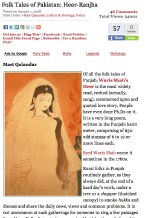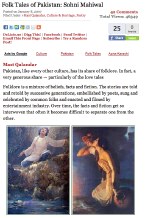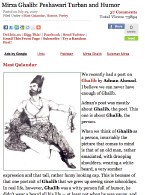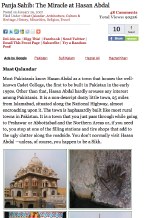It was the summer of 2006. I was in the US on a short visit, but my stay, unexpectedly, stretched a bit too long, and I started missing Islamabad, my home for the last 12 years. A friend told me to look up this new blog, All Things Pakistan (ATP), started by Professor Adil Najam, then at Tufts University. It was interesting, he said, and talked about things I might like.
Frankly, then, I didn’t quite know what a blog was, or how it worked. Nor did I know Adil Najam. I knew of him, though, as a TV show host in Pakistan, many years ago. On the show, he came across as a ‘quant’ or nerd. Remember those smart, young college students who wore round, wire-rimmed glasses and could align the Rubik Cube in no time? Perhaps it was the round glasses he wore (unless my memory is playing tricks on me), or the efficient manner in which he conducted his TV program that led me to form that impression. Later, I also found that Adil was a graduate of MIT. “Quants” always impressed me, particularly so when they had been to MIT, the Mecca of “quants.” (Another member of the then ATP editorial team, Bilal Zuberi, was also an MIT “quant.”)
My own memories of MIT, as a visitor, are not all pleasant, though. I was robbed at gunpoint in the vicinity of the campus, in front of the Hyatt Regency hotel, for the first time in my life – and hopefully the last. This was back in the late 1980s. But that does not detract in any way from the importance of MIT as a place of learning or, for that matter, from the skills and knowledge of MIT graduates. By the way, I have had other, much more satisfying, associations with MIT. But I am digressing.
The other member of ATP’s editorial team, Owais Mughal, I gathered from his initial posts, was also a “quant” – an engineer, a numbers person. I formed this impression from his earlier posts, which were mostly about railway Engines, railway stations, bridges and tunnels – and cricket scores. Sometime, as if to get away form engineering and numbers, he wrote about goats (bakras) and cooking.
Anyway, when I looked up the ATP’s website, I liked it. It talked of Pakistan that I could identify with. Some of its earlier posts were about PIA of the days of Momi Gul Durrani, Faiz Ahmed Faiz, Mehdi Hassan, Lollywood, Tangay wala Khair mangda, Maula Jatt, etc. These topics evoked nostalgia, and many ATP readers loved to walk down the memory lane and talk about the world they had left behind. ATP provided a good forum to reminisce about those times and things. It also inspired me to write for ATP.
I wrote my first post, The Caps of Pakistan, in November 2006, almost exactly four years ago. I wrote the first two or thee paragraphs while waiting to see my doctor, at the Hospital of University of Pennsylvania, Philadelphia. Expecting a long wait, I had brought my laptop with me. (I never found the magazines in doctors’ waiting rooms — or barbers’ salons — inspiring reads). And I am glad I had the laptop, because it was a particularly long wait that day. It kick started my “writing career.” I ended up writing two dozens or more posts for in the following months for ATP.
Interestingly, during all this time I never met or spoke to either Adil or Owais. My contact with them was only through emails, except once when I received a missed call on my phone from a number that I didn’t recognize. When I called back, Owais answered and was surprised to hear from me. He confessed he hadn’t called; that it must have been his young son who probably pressed the number while playing with the phone. And that was that.
Writing for a blog, I found, was exciting. What made it particularly stimulating was the immediate response it evoked from readers from virtually around the world. And ATP managed to attract a bunch of lively and loyal commenters who would show up regularly and bring something new to the table – new information, new data, new insight, a new song, a video, poetry, humor, or new something that added value to the ongoing discussion. In fact what made ATP interesting, and different from other blogs, was the quality of its comments.
Some of the names of the regular commenters from early days of ATP that readily crop up in my memory are:
- Adnan Ahmad, whose posts and comments prompted me to write on Ghalib and Manto.
- Ahmed who changed to Ahmed2 – he would quote Ghalib, Faiz, Shelley, Wordsworth or Walter Scott with equal ease and effect. My diary has many verses that I picked up from his comments, and, later, from personal exchange of emails. I found him a goldmine of information and poetry, both Urdu and English. Had he not pursued his career that he did, very successfully, too, and had opted instead for teaching, he would have made an excellent professor of literature – or even become a good poet and writer. Thanks to ATP that I got to know him.
- Ahsan (ahsan), who later became AHsn. I always suspected he was a professor of Physics or Mathematics, particularly when, in response to a post, he wrote an elaborate mathematical formula to determine the direction of the Qibla. His formula, I thought, was more complex than the Binomial theorem I battled with, unsuccessfully, in our First Year Algebra. By the time you figured his formula, the time for namaz-e-mghrib would have lapsed.
- Akif Nizam was always a pithy commenter with an ability to silence the unruly commenters with few, well-chosen words.
- For the more unruly variety, we had Omar R Quraishi, blunt as a hammer, who hit the nail on the nose.
- Talking of unruly commenters, there were very few, and they appeared only when there was a reference to religion, direct or remote. (Let’s face it, there is no escape from religion when talking about Pakistan, be it its history, culture, politics, scientific achievements — anything. After all, it’s not for nothing that they named the country Islamic Republic.)
- Then there were Anwar; Aqil Sajjad; Bhupinder; Daktar; Deeda-i-Beena; Eidee Man; Humaira; Pervaiz Munir Alvi; Roshan, the Seraiki specialist); Samdani; Sridhar; Lal salaam, whose comments were consistent with his name; Tina, a professor of literature in the bush country (?); Watan Aziz; and YLH, who not only ignited fires but also doused them, like a fire hydrant, by drowning the opponents in his arguments.
They all made ATP worth visiting, and added value to each discussion.
I sound as if I am talking of a bygone era, and not just the last four years. In digital age four years seems like ages. Many of the earlier ATP commenters seem to have vanished from the discussion board, or do not visit that frequently. I wonder why? Is it that the novelty of blogging has worn off, or the political scene in Pakistan has changed, or is it something else? I think it could be all these and some more reasons:
- One, blogs have proliferated. Even the online editions of English newspapers have become interactive blogs, providing many many forums where people can express their views.
- Two, numerous TV talk shows, which are also available online, provide vicarious satisfaction to people who want to vent their feelings about the different political issues in Pakistan.
- Three, there are so many new communication tools competing for readers’ attention: Facebook, YouTube, texting, tweeting, skyping, and they keep coming.
Facebook has given rise to a whole new generation of mostly young people who love to communicate, but have a short attention span, different reading habits and don’t bother much about the old-fashioned formalities of the language. ATP has developed a considerable following of Facebookers of its own.
The other day, out of curiosity, I looked up the profiles of some of the ATP Facebookers. They were mostly young, 20 something, and their interests and hobbies sounded very different, I guess, from the ATP commenters of yore. Talk of generation gap! Here are a few examples:
A: a college graduate, introduces himself in these words:
“hOw 2 DeScRiBe mA sElF ??? Em [name] eM FrndLy n JollY persOn.. Attitude 2 da nose!! aLwAyZ ChILLiN….n i Luv My BuDdiEs n i cant c PeOpLe SaD aRoUnD M3…I HATE LIARS — eM real moody…”
“Em siNcerE wiD mA frNdz aNd dEy all eNjOy mA coMpaNy…. ovErall eM a cHill perSoN n u ll nEvA gEt bOred ven ur wid mE…….so daZ ME”
Translated into plain English, it would read:
“How to describe myself? I’m (name), a friendly and jolly person. Always chilling and I love my buddies and I can’t see people sad around me. I hate liars, am real moody. Am sincere with my friends and they all enjoy my company … over all am a chill person and you’ll never get bored when you are with me. So that’s me.”
Among the books he likes are:
“Quran, poetry, romance, novels, world history, The Guns of August and Twilight.”
B: is a student of Edwardes College Peshawar, who lists his activities as:
“Sleeping, college, using new cell phones and laptops. My status may say I’m single … but it doesn’t mean I’m interested. My head says no. My heart says go. Why is life so complicated?”
Among the books he likes, he lists only the Holy Quran.
C : is based in London, is a college graduate and lists among his activities: “Tease (sic), driving fast and seven more.”
Among his favorite books: “Gladiator, Quran and principles of marketing.” (Not necessarily in that order, I assume.)
D: a young woman, a BBA, lists her activities as:
“Sura Al-Baqarah, Benjamin Sisters and 50 more.”
Among her favorite books, she lists:
“Holy Quran, Hadiths, horror movies and fairy tales.”
ATP’s challenge, it seems, is how to entertain and benefit – and also benefit from – the two streams of its readers, the “old” and the new?
It can be a popular meeting place; say, a tea house – lively, occasionally noisy but not rowdy – where people came, exchanged news, ideas, stories and jokes, as it was in the first two or three years, or it can become a fast food joint where people pick up their takeaways and leave, texting, tweeting, phoning – all at the same time. Or, perhaps, somehow, combine the traditional and the unconventional. I am sure Adil and his team must be thinking about this.
Meanwhile, I would love to resume my journey with ATP, but the question is what to write about: A love tale, a horror story, or something about sacred and divine?




























































MQ,
Nice to see this walk through memory lane. It was kind of you to mention me. I have enjoyed your posts over these years. I was personally first invited to this forum by Owais, who is a friend of many years (our friendship started with our shared interest in Railways – I was very interested in the history of the Karachi Circular Railway, and even created and published online a map of the line many years ago). I have enjoyed the posts of several authors here – Adil for his sensible posts on current affairs, Owais for his fun-filled posts (including recipes and memories from childhood Karachi), you for the blend of culture and history that you bring in and many others.
Why have commentators gone away. Partly because novelty has worn off. Partly because of fatigue with writing comments in a crowd (when there were fewer people, it was easier to engage in elaborate discussions). Partly because there are competing avenues (even other blogs). Partly because people’s lives change (marriage, kids etc.). But I do think a majority of those original commentators continue to visit and read even if they don’t write comments (I certainly do).
As to what you should write about – I would love to read pretty much anything you would like to write – it is such a pleasure to read.
Once again, it is a pleasure to read your post again.
Dear MQ:
You have asked what you should write about– a love tale, a horror story, or something sacred and divine? Please do, do write about love… you deal with it so well. Need I remind you of Ghalib:
Ishq say hum nay zeest ka maza paya
Dard ki dawa pa’ie dard la dawa paya
You are being unfair on the Facebook readers.
I have been following ATP from its beginning but now I follow it mostly via Facebook. That is what tells me when the new posts come. I do not follow the comments on Facebook but come (via FB) to this page for the comments, but ATP on Facebook has become my door to Pakistaniat.
MQ
Thanks for an interesting Post, full of Nostalgia which I too share.
As for your last question: What to write?
My suggestion is: Write anything as long as it fits within ALL THINGS PAKISTAN!
A joy to read this, MQ. 4 ½ years is a long time in this digital age but I still remember that summer of 06 when Bilal shared with his class mates Adil’s edited video and this blog. I came and then I never left. It used to be that when commenting I would have an audience of 6-8 people in mind; now I know that audience has multiplied by manifolds and it is wise to practice restraint in what I write here or how often. I see that almost all original regulars are practicing that restraint. A few weeks ago I had a fear that this blog may get deviated from the path chosen earlier but soon after that fear was gone. That was because Adil and Owais listen, and that’s what make them and this blog different. Adil Najam is one of the few people I look up to (strange to write about someone I have known only through this blog) and I pray that he stays the same in the way he has run this blog with Owais. On a lighter note, who knew that a nerdy looking host (yes it was the glasses) who would get stuck on the word tamgha (taghma) one day while covering SAF games on PTV could be so towering and prolific later on in life.
Samdani’s comment should be taken as feedback by other commenters. And I ask him to join the discourse here like he used to.
I end with perhaps the finest lines written by Amjad Islam Amjad;
Waqt se kaun kahe, yaar, zara aahista
Gar nahi wasl, to ye khaab-e-rafaqat hi zara dair rukey